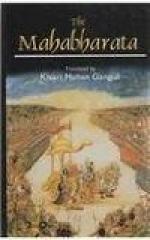36. It is said that for obtaining a worthy son, Krishna underwent the austerest of penances on the breast of Himavat, with a view to gratifying the god Mahadeva. The son obtained as a boon from Mahadeva was Samva, as would appear from this and the succeeding verses. Elsewhere, however, it is stated that the son so obtained was Pradyumna begotten upon Rukmini. The inconsistency would disappear if we suppose that Krishna adored Mahadeva twice for obtaining sons.
37. Dhava is Anogeissus latifolia. Wall, sin, Conocarpus latifolia Roxb. Kakubha is otherwise called Arjuna which is identified with Terminalia Arjuna, syn. Pentaptera Arjuna. Kadamva is Nauclea cadamba, Roxb. Kuruveka is Barleria cristata, Linn. Ketaka is Pandanus odoratissimus, Linn. Jamvu is Eugenia Jambolana. Patala is Stereospermum suaveolens syn. Bignonia suaveolens, Roxb. Varunaka is Crataea, religiosa, syn. Capparis trifoliata, Roxb. Vatasanabha is Aconitum ferox, Wall. Vilwa is Aegle Marmelos. Sarala is Pinus longifolia, Roxb. Kapittha is Feronia Elephantum. Piyala is Buchanania latifolia. Sala is Shorea robusta. Vadari is Zisyphus jujuba. Kunda is Balanites Roxburghii, Punnaga is Callophyllum inophyllum. Asoka is Saraca. Indica, Linn, syn Jonesia Asoka, Roxb. Amra is Mangifera Indica. Kovidara is Bauhinia, accuminata Linn. Champaka is Michelia Champaka, Linn. Panasa is Artocarpus integrifolia, Linn.
38. Ganga is represented as the daughter of Rishi Jahnu, and hence is she known by the name of Jahnavi. What is meant by Jahnavi having been always represent there is that the goddess always stayed there in spirit, desirous of conferring merit upon those that would reverence her.
39. i.e., never searching for food but taking what they saw, and never using their hands also.
40. Graha is literally a planet; here, Mandara who is likened to an evil planet in consequence of the mischief he did unto all.
41. Yoga in verse 84 is explained by the commentator as meaning the power of creation. Chandra-Surya-parjanya-prithivyadi-sristi-samarthyam. Similarly, by Saswatam Valam is meant that power which arises from Brahmavidya.
42. Surabhi is the celestial cow, the original progenetrix of all kine in Heaven and on Earth.
43. A Sanyasin is one that bears the stick as the badge of the mode of life he has adopted. Chatrin is the king. Kundin is one with the calabash. The meaning is that it is Mahadeva who becomes the Sanyasin or the mendicant on the one hand and the monarch on the other.
44. Every person belonging to the three superior orders bears the Upavita or sacred-thread as his badge. The deities also, including Mahadeva, bear the Upavita. Mahadeva’s Upavita is made of living snakes.
45. Arupa is formless, or as the commentator explains, nishkala, i.e., without parts, being indivisible. Arupa is of the form of multifarious acts or operations or effects in the universe. Adyarupa is Hiranyagarbha.




